Coronavirus (COVID-19): modelling the epidemic (issue no 3)
Latest findings in modelling the COVID-19 epidemic in Scotland, both in terms of the spread of the disease through the population (epidemiological modelling) and of the demands it will place on the system, for example in terms of health care requirement.
This document is part of a collection
Coronavirus (COVID-19): modelling the epidemic in Scotland (Issue No 3)
Background
This is an update on the Scottish Government modelling of the spread and level of Covid-19 using data from the week up to the 29 May 2020. This updates the previous publication on modelling the spread and level of Covid-19 in Scotland published on the 28 May 2020 which was based on data up to 15 May 2020. The estimates in this document help the Scottish Government, the health service and the wider public sector plan and put in place what is needed to keep us safe and treat people who have virus, e.g. to decide how many Intensive Care Beds (ICU) we need available for Covid patients.
Key Points
- Modelling of the epidemic in Scotland is undertaken to look at the progression of the epidemic and to inform logistical response required.
- This is done over two time periods. Short term, for the next two weeks, and longer term. Both these help to forecast Covid-19, which helps the public sector in Scotland plan their response and helps determine if the measures in place are working.
- We use the value of R to talk about Covid-19 in Scotland. Up to the
29 May, R in Scotland was estimated to be between 0.7 & 0.9. - The modelling shows that the number of infectious people, the number of cases, hospital and ICT use and deaths are all likely to continue to fall over the next two weeks.
- These forecasts were based on the "stay at home" guidance in place up to 28 May and do not reflect changes associated with the easing of these measures. The longer term forecasts will be closely monitored against actual cases over the next few weeks as the situation changes.
What the modelling tells us
Figure 1 shows how Rt for Scotland has changed since February. Before the "stay at home" restrictions were put in place Rt was above 1, and likely to have been between 4 and 6 before any interventions were put in place.
The model estimates the Rt value for Friday 29 May to be between 0.7 and 0.9.
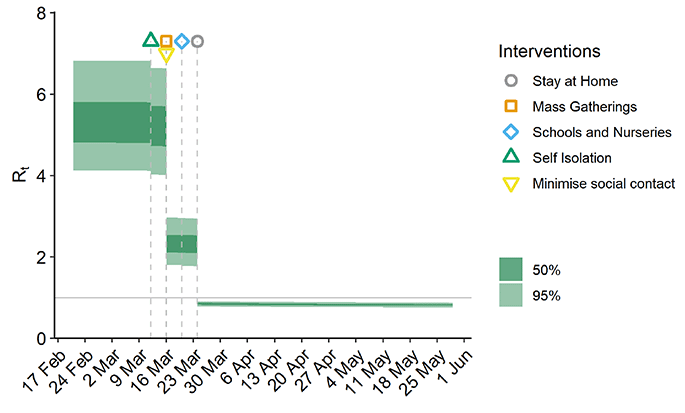
Source: Scottish Government modelled estimates using Imperial College model code,
Source: Actual data from https://www.gov.scot/publications/coronavirus-covid-19-trends-in-daily-data/
The value of Rt in Scotland is estimated by a range of independent modelling groups based in universities. These modelling groups present their estimates to the Science Pandemic Influenza Modelling group (SPI-M) for discussion. SPI-M is a sub group of SAGE and provides expert advice on scientific matters relating to the UK's response to an influenza pandemic or other emerging human infectious disease threats. SPI-M's advice is based on infectious disease modelling and epidemiology.
Different modelling groups use different data sources and methodologies to estimate Rt using complex mathematical models that simulate the spread of infections. These individual estimates, produced by independent modelling groups and the Scottish Government, are then combined to form a consensus range which Rt is very likely to be within. The estimate of Rt calculated by the Scottish Government feeds in to this process and falls within the range of values calculated by other groups and the consensus range (Figure 2). The SAGE consensus view, as of 28 May, was that the value of Rt in Scotland was between 0.7 and 0.9.
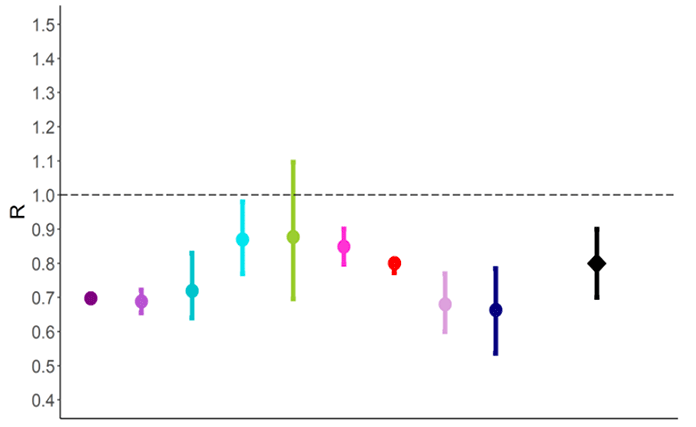 SAGE consensus value is the right-most value (black)."/>
SAGE consensus value is the right-most value (black)."/>
Source: Scientific Advisory Group for Emergencies (SAGE).
Epidemiological modelling conducted by the Scottish Government estimates the number of infectious people in Scotland on 29 May to be around 11,500 (see Table 1). Forecasts indicate this number will decline over the following two weeks, but is still at a level that could cause risk to the health service if onwards transmission rose. This figure is lower than was forecast previously, and reflects the fact that the number of deaths last week was lower than expected.
| Estimated Infectious Pool | |||
|---|---|---|---|
| Date | Mid | Lower | Upper |
| 08 May 2020 | 20,500 | 15,000 | 27,000 |
| 15 May 2020 | 17,000 | 11,500 | 23,000 |
| 22 May 2020 | 14,000 | 9,000 | 20,000 |
| 29 May 2020 | 11,500 | 7,000 | 17,000 |
| 05 June 2020 | 9,500 | 5,500 | 14,500 |
| 12 June 2020 | 8,000 | 4,000 | 12,500 |
Figure 3 shows the epidemiological forecasts produced by the Scottish Government, given the present set of interventions. This epidemic curve continues to show signs of reducing.
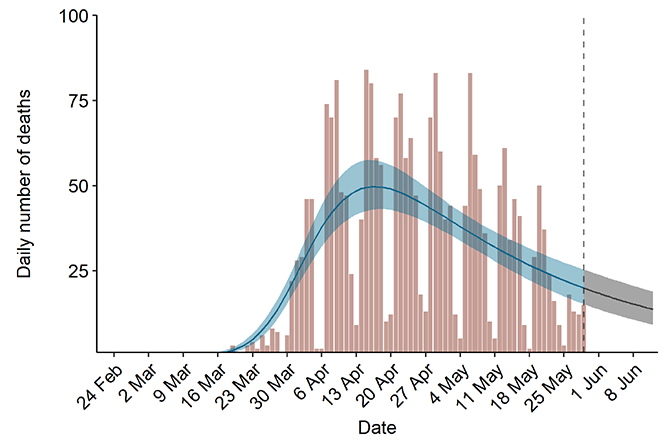
Source: Scottish Government modelled estimates using Imperial College model code,
Source: Actual data from https://www.gov.scot/publications/coronavirus-covid-19-trends-in-daily-data/
Short-term forecasts of the epidemic in Scotland are also produced by the modelling groups represented at SPI-M.
Separate forecasts are produced by each group using different models and approaches. These individual forecasts are then combined to form a consensus forecast. Forecasts come from transmission models of the epidemic process and are fitted to hospital and death data. Where data series are inconsistent (for example if ICU occupancy drops much more quickly than general bed occupancy), the models may not always fit well to the data. Note that the models used for these short-term forecasts are different to those used for longer term forecasts, such as those evaluating the possible impact of changes to social distancing measures, and those used to estimate Rt.
Each group fits their model to the trends in the historical data. As a result, these forecasts do not include the possible impact of the changes to social distancing measures which have been announced by the Scottish Government and other UK administrations, but which have not yet resulted in changes to hospital or death data by the time the forecasts were made.
Figure 4. Consensus short-term forecast of hospital bed occupancy in Scotland as of 28 May, produced by SAGE.
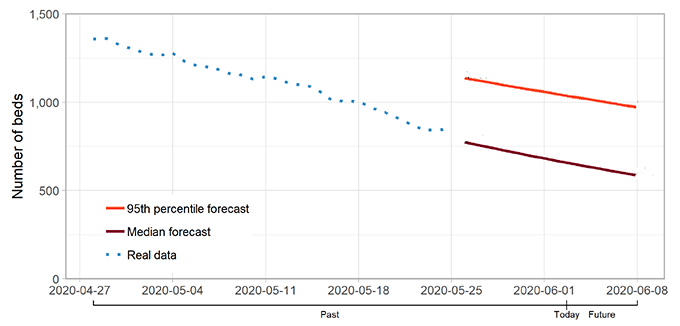
Source: This figure has been produced by the Scottish Government using the forecast data provided by SAGE.
This short-term modelling suggests the number of hospital beds occupied by Covid-19 patients in Scotland will continue to fall over the next two weeks (Figure 4). This is well within our Covid-19 capacity of 4,250.
The medium-term forecasts produced by the Scottish Government (Figure 5) using the logistics model show a similar story over the next few months, with a steady decline in the number of people requiring a hospital bed from Covid-19.
These forecasts are based on the "phase 1" measures to begin relaxing lockdown. These measures began on 29 May, and we will not be able to reliably measure the effect of this for around three weeks. Instead, the forecasts are based on other European countries that have enacted some of the phase 1 measures, and we will monitor the impact of these changes in the coming weeks, and how this will effect hospital demand.
The three scenarios presented in Figure 5 for hospital demand and Figure 6 for ICU demand are for different levels of daily infections. In each case, we translate these into logistical forecasts which are used for planning purposes.
The Worse scenario and Better scenario should not be considered an upper and lower bound. It is important to note, in particular, that for planning reasons many of the assumptions used are deliberately precautionary, and so it is reassuring that actual case data are lower than the modelled estimate in the past, as is the case with the ICU demand forecast in Figure 6.
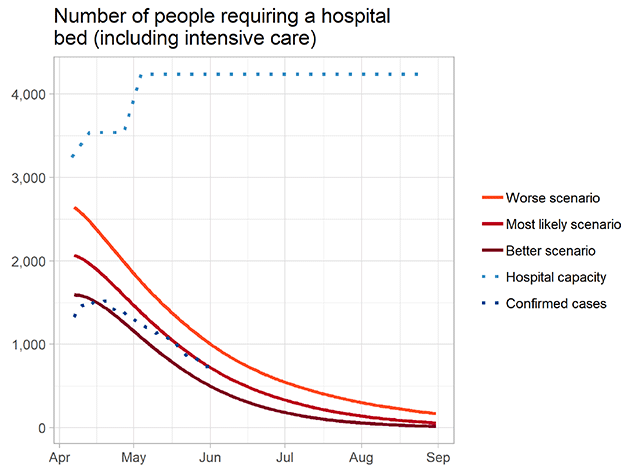
Source: Scottish Government modelled estimates using outputs from the Imperial College model code,
Source: Actual data from https://www.gov.scot/publications/coronavirus-covid-19-trends-in-daily-data/
The logistical model also provides us with a medium term forecast of the number of ICU beds which may be required (Figure 6).
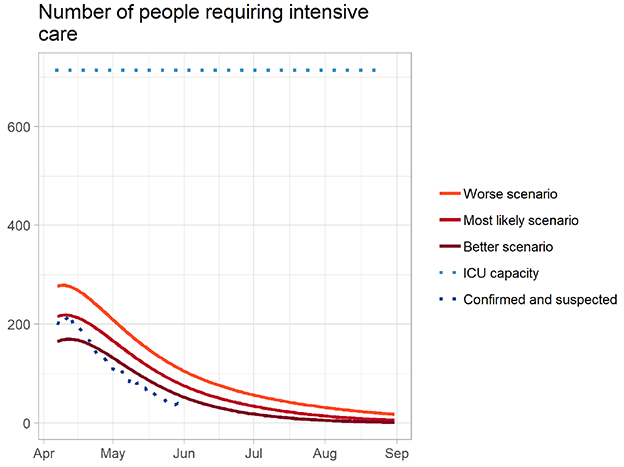
Source: Scottish Government modelled estimates using outputs from the Imperial College model code,
Source: Actual data from https://www.gov.scot/publications/coronavirus-covid-19-trends-in-daily-data/
What next?
The modelled estimates of hospital and ICU use, and of the reproduction number Rt will be published each week. Further information can be found at
Contact
There is a problem
Thanks for your feedback